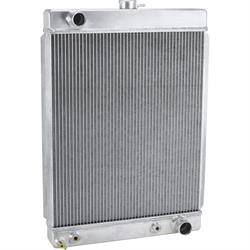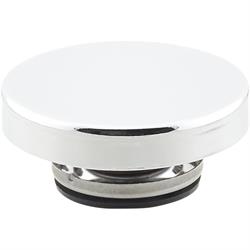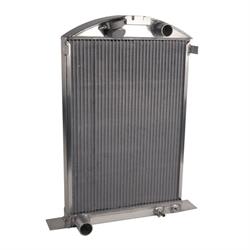Differences Between Downflow and Crossflow Radiators
Radiators are offered in a two basic configurations which differ to fit the space available, add mounting rigidity and offer varying inlet and outlet locations. The two commonly used radiator designs are downflow and crossflow. Each design offers its own advantages and disadvantages that we'll examine in more detail below.
How Does a Downflow Radiator Work?
Downflow radiators have the tanks located at the top and bottom of the radiator's core. The coolant enters through the top tank and flows down through the core with the help of gravity easing the work load of the water pump as the coolant returns to the engine. This design fits early cars and trucks well which have a tall but narrow width grille and radiator support. Pre-war hot rods, classic trucks, and many muscle cars from the 60s used downflow radiators. The downflow radiator also has the advantage of inlet and outlet placement. The inlets and outlets can be positioned in the center, left, right or anywhere in between. Moving the outlets often is the only modification needed when updating to a newer engine or changing engine families.
The disadvantage to a downflow radiator is the radiator cap placement. Since the radiator cap must be positioned on the top tank it is exposed to the high pressure side of the cooling system. This significantly increases the need for the cap to vent off excess pressure. When the cap vents off excess pressure in a downflow radiator it almost always allows some coolant to escape the system, which is due to the cap location and extreme agitation of the coolant at the inlet. In order to reduce the chances of venting off excessive amounts of coolant we suggest using a higher pressure cap on a downflow radiator. Using a 15 to 25 psi radiator cap is typical for downflow radiators. A radiator cap pressure rating of less than 15 psi typically does not work well on a downflow radiator, especially in hot temperatures like 90 degrees Fahrenheit and up.
What Are The Benefits of A Crossflow Radiator?
Crossflow radiators have the tanks located on the left and right sides of the radiator. Coolant enters the radiator at one side and the water pump forces coolant through the core to the opposite side of the radiator on its way back to the engine. This design works well in later cars and trucks with a wide grille opening.
The crossflow design allows the radiator cap to be positioned on the low pressure (suction) side of the system, allowing for lower pressure radiator caps to be used, such as 7 to 20 psi. Another advantage to the radiator cap location on crossflow radiators is that when venting excess pressure it is more likely to vent off air from the system instead of coolant. This is due to less coolant agitation within the low pressure tank.
Crossflow radiators are an excellent choice for racing applications and hard to cool vehicles such as big blocks or boosted engines in street cars and hot rods. For circle track racing applications with increased cooling system demand, a high pressure radiator cap between 22 psi and 32 psi is suggested.
Is A Double Pass Radiator A Better Choice?
Crossflow radiators are also offered in double pass and even triple pass designs. These different designs enhance the radiator's ability to cool by increasing the number of times the coolant passes through the core of the radiator. To learn more about double and triple pass radiators we have produced the article Single Pass, Double Pass, Triple Pass Radiators; What’s The Difference? right here on The Toolbox.
Related Articles To Help With Your Product Decisions
Shop for Radiators and Cooling System Components
Updated by Mark Houlahan







